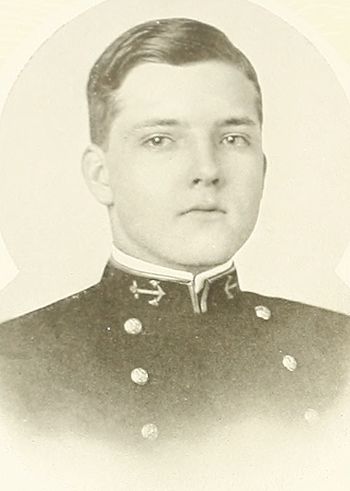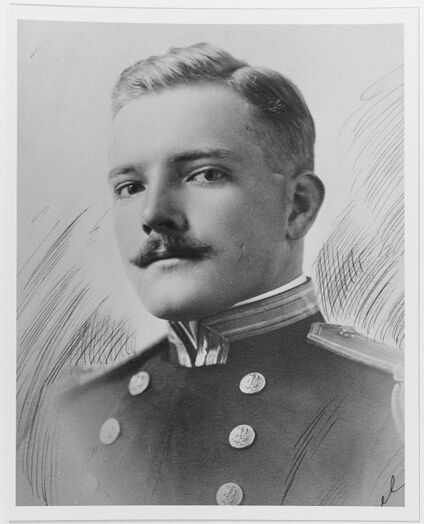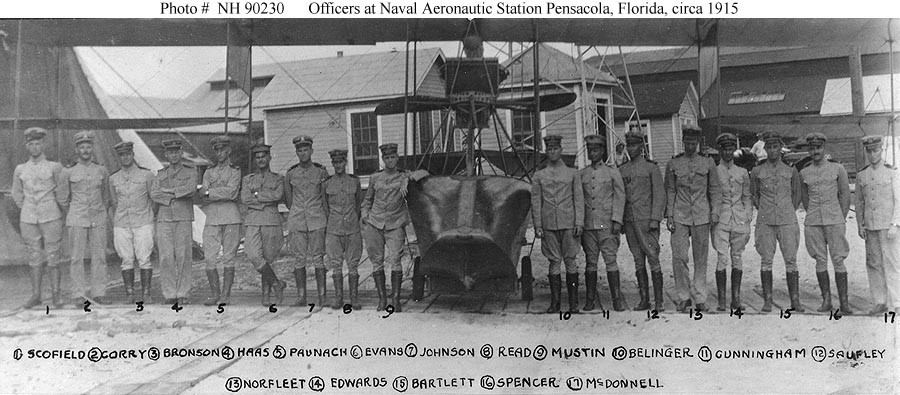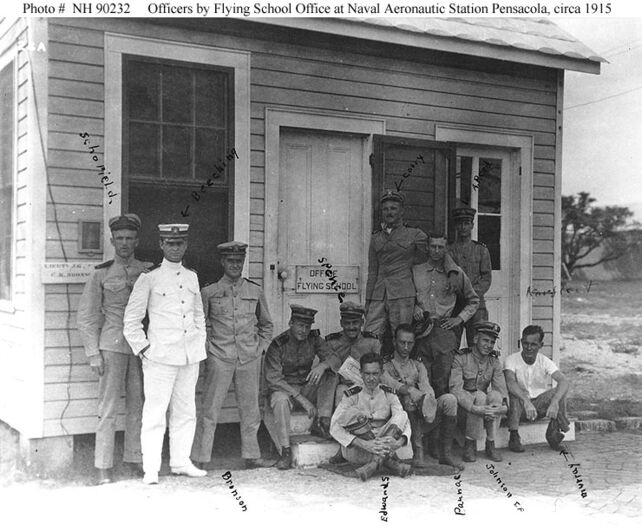WILLIAM M. CORRY, JR., LCDR, USN
William Corry '10
Lucky Bag
From the 1910 Lucky Bag:
William Merrill Corry, Jr.
Quincy, Florida
"Bill"
A happy old hot sport is Bill,
Whose cheerfulness gets him his fill
Of the good things of life,
Sans trouble and strife,
Though his gab may perchance make you ill.
HERE we have a jolly companion and a boon friend whose friendship does not consist of words only. Those who look first on his jolly countenance and see his contagious smile think only of the fun loving youth; but we, who know him, know that he has a man's head coupled to a boy's heart and live enthusiasm. Drew three stripes on his personality and kept them on his ability. Likes to hand out high sounding bluffs to the profs.; but no man ever called him a greaser. Has a fondness for the French capital and wishes there were a European squadron. You can get a rise any time by asking him about the time he swam the bases and scored the winning run. This is Bill, one of the best of us and one of the best liked.
Chorus at hops when Ethel doesn't attend: "Oh! Where is my cherub to-night?"
Baseball (2, 1). White N 2d. Class Baseball (4, 3). Masqueraders (1). Sharpshooter. Three Stripes (a, b)

William Merrill Corry, Jr.
Quincy, Florida
"Bill"
A happy old hot sport is Bill,
Whose cheerfulness gets him his fill
Of the good things of life,
Sans trouble and strife,
Though his gab may perchance make you ill.
HERE we have a jolly companion and a boon friend whose friendship does not consist of words only. Those who look first on his jolly countenance and see his contagious smile think only of the fun loving youth; but we, who know him, know that he has a man's head coupled to a boy's heart and live enthusiasm. Drew three stripes on his personality and kept them on his ability. Likes to hand out high sounding bluffs to the profs.; but no man ever called him a greaser. Has a fondness for the French capital and wishes there were a European squadron. You can get a rise any time by asking him about the time he swam the bases and scored the winning run. This is Bill, one of the best of us and one of the best liked.
Chorus at hops when Ethel doesn't attend: "Oh! Where is my cherub to-night?"
Baseball (2, 1). White N 2d. Class Baseball (4, 3). Masqueraders (1). Sharpshooter. Three Stripes (a, b)
Loss
William was lost on October 6, 1920 when he died of injuries sustained when the aircraft he was aboard crashed near Hartford, Connecticut on October 2.
Other Information
From Wikipedia:
Corry was born at Quincy, Florida. Admitted to the Naval Academy in June 1906, he graduated in 1910 and spent the next five years serving in the battleship USS Kansas. In mid-1915, Lieutenant (Junior Grade) Corry began instruction in aviation at Pensacola, Florida, and was designated Naval Aviator #23 in March 1916. He had flying positions with the armored cruiser USS Washington between November 1916 and May 1917, then was an officer on the armored cruiser USS North Carolina.
In August 1917, Lieutenant Corry began World War I service in France, where he commanded Naval Air Stations at Le Croisic and Brest during 1918 and early 1919. He was promoted to lieutenant commander in July 1918. Corry remained in France for the rest of 1919 and the first half of 1920, involved in removing U.S. Naval Aviation forces from Europe as part of the post-war demobilization.
In mid-1920, Lieutenant Commander Corry was assigned as aviation aide to the Commander-in-Chief, Atlantic Fleet, stationed on the Fleet's flagship, USS Pennsylvania. On October 2, 1920, he was a passenger on a flight from Long Island, New York. The airplane crashed near Hartford, Connecticut. Though thrown clear of the wreckage, the injured Corry ran back to pull the pilot free of the flaming aircraft. Fatally burned during this rescue, William M. Corry died at Hartford on October 6. He posthumously received the Medal of Honor for his heroism.
From researcher Kathy Franz:
On July, 7, 1915, a new Wright flying machine from the works at Dayton, Ohio, arrived at the aeronautic station in Pensacola. An aviator arrived to assemble the machine and give it the required tests before it was presented to the navy for acceptance. William and others also arrived that day for aviation instruction.
In May 1916 William was best man at his brother Arthur’s marriage in Passaic, New Jersey. Afterward, when boarding a train for New York, a man reached into his coat pocket and drew out a roll of bills. Patrolman Farrel, standing nearby, witnessed the theft and jumped aboard the train. He had the train stopped and arrested the thief and two other men with him. William got his $60 back.
In March 1920 William was listed on the census of the U. S. Naval Staff office in Paris, France.
His father William was president of the Owl Tobacco Company, mother was Emily, and siblings were Albert, Walden, Arthur, Alice, and Edwin.
From the Hartford Courant on October 4, 1920:
Lieutenant Arthur C. Wagner, United States Naval Air Service, died about 10 o’clock last night after lingering for nearly eight hours in agony from burns he received when the naval Curtis airplane which he and Lieutenant Commander William Merrill Corry, commander of the Atlantic fleet air section, were starting on their return journey to Mineola, L. I., capsized and burned up on the grounds of the Hartford Golf Club yesterday afternoon. Corry received several broken ribs when he was spilled from the machine as it fell and when he returned to the aid of his comrade he was terribly burned about the face and hands.
Walter E. Batterson, Colonel Hamilton R. Horsey, former assistant chiefs of the staff of the Twenty-sixth Division, and Martin Keane, all of this city, were burned while aiding Corry to extricate Wagner from the flaming mass which had been the plane.
The plane had just been started on the return trip to the Mineola Air Station, when the two aviators had come on Saturday afternoon in a cross country flight and was receiving all possible attention from a number of club members on the veranda and tennis courts at the time of the accident.
Lieutenant Wagner was in the forward or pilot’s seat and Lieutenant Commander Corry in the rear passenger seat. While there are controls in both seats, Wagner was piloting the plane. People who were gathered around the start disagree on whether Wagner remarked that the plane was out of order. Some say that he said it was running perfectly.
The start was made in a northerly direction but when the plane was about fifty feet in the air it turned completely around and headed southwest. As it was passing over the clubhouse Commander Corry waved to Colonel Horsey and Lieut. Colonel James S. Howard, secretary of the Travelers Insurance Company, whose guests the two officers had been and everything appeared to be going well with the machine. Just beyond the club is a large grove of trees which seemed to the onlookers to be offering interference to the clear flight of the machine. At any rate, just before reaching the grove the plane swerved sharply to the right and was heading back in a northerly direction when it suddenly made a nose dive from an altitude of about seventy-five feet. Onlookers were not agreed on what happened just before the crash but it was thought that the engine had stopped. This was later found to be the case.
The machine hit the ground at a sharp angle and immediately turned over endwise, the propeller catching in the ground. Commander Corry was catapulted from his seat, but Wagner, who had strapped himself into his seat, was less fortunate. As the machine turned over it burst into flames, enveloping him in a wash of blazing gasoline from the broken tank.
Commander Corry picking himself up from the ground, was the first to rush to the aid of his comrade. It was in this way that his coat caught fire with the resulting burns to his hands and face. He was unable to pull Wagner free and it was not until Walter E. Batterson of the Travelers Insurance Company, and Martin Keane, an attaché of the club, added their efforts this was successfully accomplished. Club members rushed form the clubhouse with several gallons of olive and sweet oil and were on hand almost as soon as the stricken man was freed from his seat. While the burning clothing was being removed from Wagner’s body, Benjamin Allen, a porter in the club, quickly wrapped his coat around Corry’s head and this cut off any chance of the flames reaching the officer’s nose or eyes.
Allen then, with Corry helping, removed the coat and smothered the other smoldering pieces of clothing. Corry’s hands and face were burned so badly that not a trace of skin was left untouched. Several ribs were also broken.
Wagner was rolled over on the ground by willing hands to extinguish the flames, and with the help of the two men who had dragged him from his place beneath the plane, much of his clothing as still remained unburned was stripped from his body, to make way for dressings in olive and sweet oil, which by this time were available. He was wrapped in swaths of oil soaked linen and cotton sheeting to allay the agony of his burns. Every scrap of clothing was almost entirely consumed and his shoes were burned to a crisp. Throughout the process, Wagner, fully conscious, was directing the efforts of the willing helpers, despite the fact that his face was burned beyond recognition with nose and ears partly burned from his head.
He remained game even to the time when he was being tenderly lifted to the ambulance, when he thanked those who had helped telling them that he was sure they had done all they could to aid him.
From the Meriden Morning Record, Connecticut on October 4, 1920:
Lieutenant Arthur C. Wagner, of Wayburn, Saskatchewan, was killed and Lieutenant Commander William Merrill Corry, Jr., commanding officer of the aviation section of the Atlantic fleet, was seriously injured, when an airplane in which they were riding crashed to the ground on the Hartford Golf club course late today. . .
Persons who saw the crash from the club veranda rushed to the scene with olive oil and gave first aid to Wagner and Corry. The former was in such agony that no effort was made to move him until an ambulance arrived. Meanwhile William H. Mann, a member of the club, drove his automobile across the golf course and Corry was placed in it and whirled away to a hospital. He was reported in a serious condition tonight, suffering from severe burns on the head and hands, in addition to the fractured ribs. Wagner was burned about the entire body and died at 10 o'clock tonight.
Lieutenant Commander Corry is stationed on the battleship Pennsylvania. His home is in Quincy, Fla.
From the Hartford Courant on October 8, 1920:
Lieutenant Commander William M. Corry . . . died in the Hartford Hospital early yesterday morning.
The death of Lieutenant Corry followed a brave fight for life, but he was so seriously burned on Sunday when he rushed to the rescue of Lieutenant Arthur C. Wagner . . . that there was little hope for recovery. In the opinion of several local aviation authorities, including Hiram Percy Maxim, and John J. Van Schaack, former overseas flier, the accident Sunday was directly due to the use of automobile grade gasoline, the higher proof "gas" not being available then in Hartford.
Mr. Maxim said yesterday that hereafter any fliers visiting Hartford need have no fear of a shortage of high grade gasoline as arrangements have been made to keep a supply in the city. [It was later noted that the plane had no shelter the night before, so the engine was chilled.]
He was survived by his wife, parents, and three siblings. He is buried in Connecticut.
Photographs
Medal of Honor
From Hall of Valor:
The President of the United States of America, in the name of Congress, takes pride in presenting the Medal of Honor (Posthumously) to Lieutenant Commander William Merrill Corry, Jr., United States Navy, for heroic service in attempting to rescue a brother officer from a flame-enveloped airplane near Hartford, Connecticut. On 2 October 1920, an airplane in which Lieutenant Commander Corry was a passenger crashed and burst into flames. He was thrown 30 feet clear of the plane and, though injured, rushed back to the burning machine and endeavored to release the pilot. In so doing he sustained serious burns, from which he died four days later.
Service: Navy
From Hall of Valor:
The President of the United States of America takes pleasure in presenting the Navy Cross to Lieutenant Commander William Merrill Corry, Jr., United States Navy, for distinguished and heroic service as an Airplane Pilot making many daring nights over the enemy's lines, also for untiring and efficient efforts toward the organization of U.S. Naval Aviation, Foreign Service, and the building up of the Northern Bombing project.
Service: Navy
Division: Northern Bombing Group
Namesake
USS Corry (DD 334), USS Corry (DD 463), and USS Corry (DD 817) were all named for William.
Memorial
William's classmates erected a plaque in his honor in Memorial Hall.
Related Articles
Richard Saufley '08 and Clarence Bronson '10 were also pictured among the earliest naval aviators.
Officers at the Naval Aeronautic Station, Pensacola, Florida, circa July-November 1915. They are standing in front of a Curtiss AB type seaplane, and include both station staff and student aviators. They are identified (as numbered on the print) as: 1. Lieutenant (Junior Grade) Harold W. Scofield, USN; 2. Lieutenant (Junior Grade) William M. Corry, Jr., USN; 3. Lieutenant (Junior Grade) Clarence K. Bronson, USN; 4. Lieutenant (Junior Grade) Ewart G. Haas, USN; 5. Lieutenant (Junior Grade) Robert R. Paunack, USN; 6. 1st Lieutenant Francis T. Evans, USMC; 7. Lieutenant Earle F. Johnson, USN; 8. Lieutenant Albert C. Read, USN; 9. Lieutenant Commander Henry C. Mustin, USN, Naval Aeronautic Station Commandant; 10. Lieutenant (Junior Grade) Patrick N.L. Bellinger, USN; 11. 1st Lieutenant Alfred A. Cunningham, USMC; 12. Lieutenant (Junior Grade) Richard C. Saufley, USN; 13. Lieutenant (Junior Grade) Joseph P. Norfleet, USN; 14. Lieutenant (Junior Grade) Walter A. Edwards, USN; 15. Lieutenant (Junior Grade) Harold T. Bartlett, USN; 16. Lieutenant (Junior Grade) Earl W. Spencer, Jr., USN; 17. Lieutenant (Junior Grade) Edward O. McDonnell, USN. Photograph from the photo album of Vice Admiral T.T. Craven. Courtesy of Lieutenant Rodman DeKay, Jr., USNR (Retired), 1979. U.S. Naval History and Heritage Command Photograph.
"They are outside the Flying School office, which bears a sign (at left) with the name of Lt. j.g. Clarence K. Bronson. Both station staff and student aviators are present. Most are identified below (as annotated on the print). Standing, left to right: Ensign Harold W. Scofield, USN; Past Assistant Surgeon Charles L. Beeching, USN; Lt. j.g. Clarence K. Bronson, USN; Lt. j.g. William M. Corry, Jr., USN; Lt. j.g. Joseph P. Norfleet, USN; and Lt. Albert C. Read, USN. Seated, left to right: Unidentified Lt. j.g.; Lt. j.g. Earl W. Spencer, Jr., USN; Lt. j.g. Walter A. Edwards, USN; Lt. j.g. Robert R. Paunack, USN; Lt. Earle F. Johnson, USN; Lt. j.g. George D. Murray, USN. Photograph from the photo album of Vice Admiral T.T. Craven. Courtesy of Lt. Rodman DeKay, Jr., USNR (Retired), 1979. U.S. Naval Historical Center Photograph."
The "Register of Commissioned and Warrant Officers of the United States Navy and Marine Corps" was published annually from 1815 through at least the 1970s; it provided rank, command or station, and occasionally billet until the beginning of World War II when command/station was no longer included. Scanned copies were reviewed and data entered from the mid-1840s through 1922, when more-frequent Navy Directories were available.
The Navy Directory was a publication that provided information on the command, billet, and rank of every active and retired naval officer. Single editions have been found online from January 1915 and March 1918, and then from three to six editions per year from 1923 through 1940; the final edition is from April 1941.
The entries in both series of documents are sometimes cryptic and confusing. They are often inconsistent, even within an edition, with the name of commands; this is especially true for aviation squadrons in the 1920s and early 1930s.
Alumni listed at the same command may or may not have had significant interactions; they could have shared a stateroom or workspace, stood many hours of watch together, or, especially at the larger commands, they might not have known each other at all. The information provides the opportunity to draw connections that are otherwise invisible, though, and gives a fuller view of the professional experiences of these alumni in Memorial Hall.
January 1911
January 1912
January 1913
January 1915
January 1916
January 1917
March 1918
January 1919
January 1920
Memorial Hall Error
William was a "Jr."; this suffix is missing from the Class of 1910 panel in Memorial Hall. (It is included on the plaque erected in his honor, however, which is in Memorial Hall.)

The "category" links below lead to lists of related Honorees; use them to explore further the service and sacrifice of alumni in Memorial Hall.


